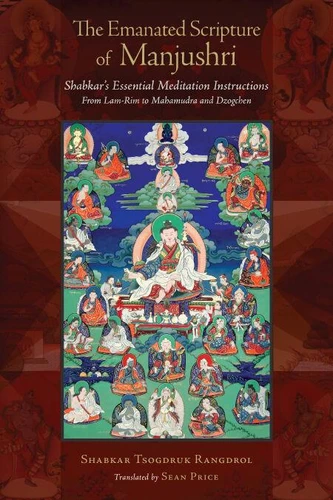The Emanated Scripture of Manjushri. Shabkar's Essential Meditation Instructions
Par : ,Formats :
Disponible dans votre compte client Decitre ou Furet du Nord dès validation de votre commande. Le format ePub protégé est :
- Compatible avec une lecture sur My Vivlio (smartphone, tablette, ordinateur)
- Compatible avec une lecture sur liseuses Vivlio
- Pour les liseuses autres que Vivlio, vous devez utiliser le logiciel Adobe Digital Edition. Non compatible avec la lecture sur les liseuses Kindle, Remarkable et Sony
- Non compatible avec un achat hors France métropolitaine
 , qui est-ce ?
, qui est-ce ?Notre partenaire de plateforme de lecture numérique où vous retrouverez l'ensemble de vos ebooks gratuitement
Pour en savoir plus sur nos ebooks, consultez notre aide en ligne ici
- Nombre de pages240
- FormatePub
- ISBN978-0-8348-4173-4
- EAN9780834841734
- Date de parution05/02/2019
- Protection num.Adobe DRM
- Taille11 Mo
- Infos supplémentairesepub
- ÉditeurSnow Lion
Résumé
Instructions for traversing the entire Vajrayana path to enlightenment from one of Tibet's most famous wandering yogis. Composed by Shabkar at the Cave of Miracles close to Mount Kailash around 1815, this compendium of spiritual instructions is written in the form of questions and answers, alternating verse and prose, between Shabkar and his disciples. It presents the essence of the entire graded path to enlightenment, using Tsongkhapa's Great Graded Path (Lam rim chen mo) as its model.
In twenty-three pieces of advice, he explains the need to renounce the world, how to develop genuine compassion, and methods for achieving an undistracted mind that can unite meditation on emptiness with compassion. His nonsectarian approach is evident in his teachings on the nature of mind according to the Mahamudra tradition of Milarepa, his practical explanations of Saraha's songs of realization, and the attainment of buddhahood without meditation, which draws on the teachings of the Great Perfection, Dzogchen.
Shabkar's style is direct and fresh; his realization infuses his instructions with an authenticity that will continue to inspire Buddhist practitioners for years to come.
In twenty-three pieces of advice, he explains the need to renounce the world, how to develop genuine compassion, and methods for achieving an undistracted mind that can unite meditation on emptiness with compassion. His nonsectarian approach is evident in his teachings on the nature of mind according to the Mahamudra tradition of Milarepa, his practical explanations of Saraha's songs of realization, and the attainment of buddhahood without meditation, which draws on the teachings of the Great Perfection, Dzogchen.
Shabkar's style is direct and fresh; his realization infuses his instructions with an authenticity that will continue to inspire Buddhist practitioners for years to come.
Instructions for traversing the entire Vajrayana path to enlightenment from one of Tibet's most famous wandering yogis. Composed by Shabkar at the Cave of Miracles close to Mount Kailash around 1815, this compendium of spiritual instructions is written in the form of questions and answers, alternating verse and prose, between Shabkar and his disciples. It presents the essence of the entire graded path to enlightenment, using Tsongkhapa's Great Graded Path (Lam rim chen mo) as its model.
In twenty-three pieces of advice, he explains the need to renounce the world, how to develop genuine compassion, and methods for achieving an undistracted mind that can unite meditation on emptiness with compassion. His nonsectarian approach is evident in his teachings on the nature of mind according to the Mahamudra tradition of Milarepa, his practical explanations of Saraha's songs of realization, and the attainment of buddhahood without meditation, which draws on the teachings of the Great Perfection, Dzogchen.
Shabkar's style is direct and fresh; his realization infuses his instructions with an authenticity that will continue to inspire Buddhist practitioners for years to come.
In twenty-three pieces of advice, he explains the need to renounce the world, how to develop genuine compassion, and methods for achieving an undistracted mind that can unite meditation on emptiness with compassion. His nonsectarian approach is evident in his teachings on the nature of mind according to the Mahamudra tradition of Milarepa, his practical explanations of Saraha's songs of realization, and the attainment of buddhahood without meditation, which draws on the teachings of the Great Perfection, Dzogchen.
Shabkar's style is direct and fresh; his realization infuses his instructions with an authenticity that will continue to inspire Buddhist practitioners for years to come.



